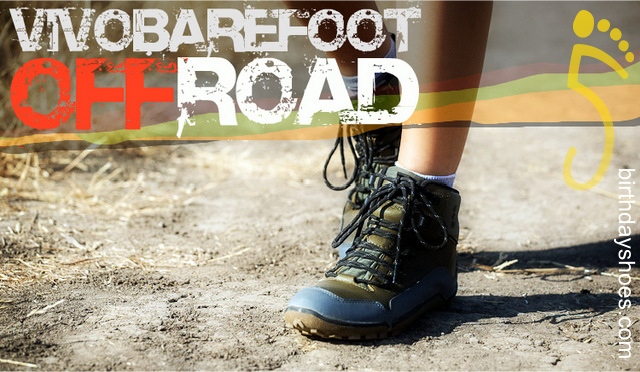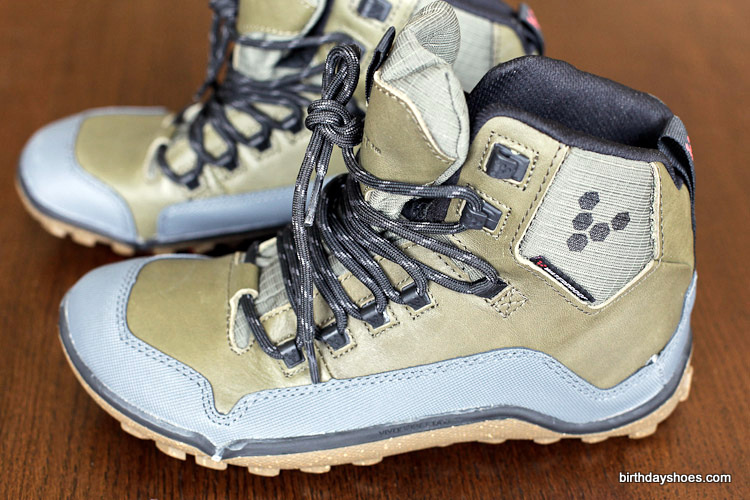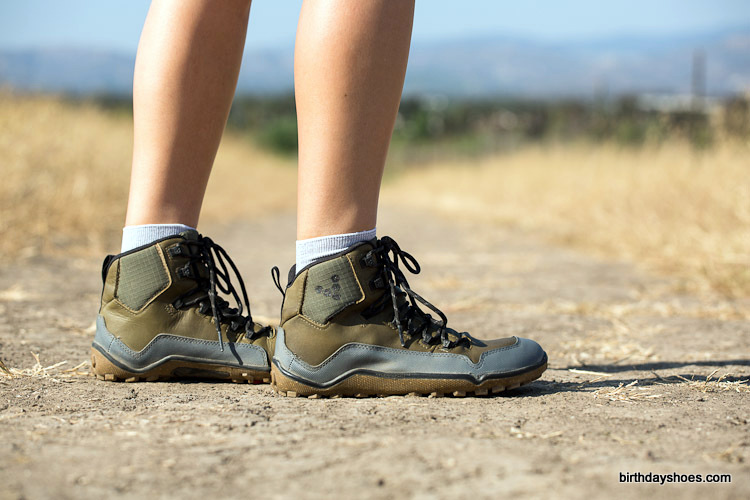Sometimes you just need an old fashioned hiking boot. But you don?t have to settle for the traditional kind. The Off Road Hi boots are VivoBarefoot?s minimalist version.
I was intrigued by the minimalist boot idea since boots tend to drag me down. Before I switched over to VFFs a few years ago, I was wearing my heavy duty Asolo boots on all my adventures. They performed well, but wow, they were like lifting dead weights with every step and I always ended up with blisters after the trip. So I was curious to see how my legs and feet would fare after a few hours of walking the trails in this minimalist version.
Looks/Design
I think the style blends right in as an average hiking boot. You really can?t tell that they?re a minimalist design by looking at them. Mine are an olive green with gray accents but it looks like they?re only offered in black and a gray/pink combo for women now. (Important to note: I think it?s unfortunate that there?s only two colors to choose from for women and one of them has to be pink). Why do they always have to pink everything just because it?s women?s specific?? I like the olive green the best. Simple and classic.
Materials/Construction
VivoBarefoot Specs
from VivoBarefoot.com:
Upper: Pull Up Leather: Vegetable tanned leather with abrasion leather and rip stop Nylon trimmings for increased durability
Lacing: Speed hook Lacing: Quick fastening with a secure and personalized fit through speed hook eyelets
Collar/Panel & Lining: Woven Nylon & Polyester, Polyurethane
Insoles: Removable: 3mm Pressed EVA Insole for additional thermal protection when necessary
Sole Construction: Off Road: Rubber outsole specifically designed for off road surfaces with directional lugs to maximize surface contact for superior barefoot traction
Outsole Thickness: 2.5mm with 4.5mm lugs: Offering maximum proprioception with protection and ultimate grip
Toe Guard: Leather Toe Guard: Abrasion-resistant leather
Weight: 325g/11.5oz
Eco Credentials: Usage of Eco Friendly materials; Minimum chrome leather; Soles made from recycled rubber; Dri-lex performance lining with environmentally sustainable Sorona yarn
I love VivoBarefoot?s use of eco-friendly materials like the use of sustainable yarns and recycled rubber in the soles…bonus! For a boot they are extremely lightweight. My size 8 weighs 12.2 oz each/24.4 a pair. Perfect for travel and will lessen the weight in your backpack. They come up high around the ankle and the back is cut a little lower at the achilles. Also, the upper is reinforced to protect your foot from rocks and debris and the lugs on the outsole are chevron shaped and are multidirectional.
Waterproof Qualities
It says in the description, ?Designed with a waterproof sock construction…barefoot boot is suitable for waterproof approach and hiking – even on the most challenging terrains.? I was curious to see how they would hold up while standing completely submerged in fresh water, so I put them through a bathtub test. It?s important to note that the tongue is not gusseted very high so you can only submerge these boots up to a certain point before your foot gets soaked. To test the boot, I filled the tub up with 2.5 inches of water and stood in it for 30 seconds. After 30 seconds I took off the boots and found that my socks were wet. It seems that water somehow leaked into the shoe through the upper. After this test, I?d say these are more of a water resistant boot rather than completely waterproof. Might be okay for quick traverses through shallow streams, but definitely not for lingering in them.
Fit/Sizing
These guys seem to run a little bit small. I have a size 38 which is equivalent to a size 8, but it fits a little too snug in the toes. I would recommend sizing up so your toes have room to move. But the proper sizing will depend on what kind of socks you plan on wearing with them. There?s also a removable footbed that can change the way it fits. I prefer wearing the boot with the footbed since it feels more complete that way – so that?s how I?m basing my sizing. Also, the interior is very soft and comfortable.
The boot comes up around the ankle in the traditional ?ankle protection? style. The laces use an eyelet system at the top that are easily adjustable. I haven?t worn a hiking boot in a long time so it felt odd to have my ankle restricted once again. Also, there?s no pressure points in the heel or hotspots anywhere in the back which is good. The only hotspots I had were in the pinky toes and big toes due to sizing.
Performance
I walked the trails on short quick hikes and also went on longer 2 hour hikes. It was pretty wild to be hiking in a boot that has a barefoot feel to it! The ground feel is good and not over the top. I could feel the rocks and ground beneath my feet unlike a typical boot with a thick outsole. If you want more ground feel you can remove the footbed, but just note that it will make it a little roomier in there.
There was a noticeable difference in height when comparing them to a traditional boot. When I wear my Asolos it feels like I?m walking on a platform. In this barefoot model my foot feels more level to the ground and I never felt like my foot wanted to ?roll?. I loved that aspect!
I could definitely tell that they were more lightweight than your typical boot too. I could walk a fast pace without feeling like I was being overly bogged down by weight. Although, since I?m used to wearing
VFFs most of the time, the weight of the boot was still noticeable to me while going downhill. This is a big factor that deters me from wearing boots since it causes IT band pain in the knee for me. I noticed some slight knee pain on the occasional downhill, but everyone?s legs are different so it might not affect someone else the same. Also, I had some pinky toe and big toe pain (especially on the downhills) due to the smaller fit. I ended up with a blister on my pinky toe because of it.
When trying on for size, there should be enough room in the toes for expansion so they don?t hit the end of the boot. The heel was very comfortable so I didn?t have any issues there.
The tread is equipped with 4.5mm multidirectional lugs which provided some great traction. I could walk up and down hills without having any issues with grip and I didn?t slip at all. I didn?t get a chance to test the tread on the trail while wet, so I?m curious to know how well they would do while rock hopping through streams. So let me know if any of you try it!
Summary
These boots are great if you?re looking for something more robust that still retains minimalist footwear qualities. I liked the fact that even though I was wearing a boot, I still felt the ground beneath my feet. The outsole allows you to be connected to the ground but also provides the right amount of protection from rocks and debris. I love that they?re lightweight too…most boots are heavy and can weigh you down. It?s a bummer that my pair fits too small because I?d love to test them out on much gnarlier hikes.
MSRP $175 (Note: the colorway seen in these photos is no longer available. Also, the Off Roads come in a “Mid” version which has a lower cut ankle covering.)
Pros —
- Great traction
- Lightweight for a boot
- Lots of ground feel
- Eco-Friendly
- Good for when you need something more robust on the trails
Cons —
- Tongue is not gusseted very high
- Runs small
- Not waterproof




25 replies on “VivoBarefoot Off Road Hi Boot Review”
i’m assuming the ankles are flexible, if they aren’t you’re just asking for an ankle sprain…
Good review. I love my Off Road Hi’s. I haven’t actually stood in water deeper than the junction between the sole and the upper, but in snow and slush and shallow water they performed really well last winter, never had water coming in, which is why I had bought them for.
Please suggest to Vivo a military desert boot. I’d pay the $175 for some. Any questions, check the Nike SFB, it’s the most comfortable boot I’ve worn, and yes, doubters, I’ve worn it in combat, both Iraq and Afghanistan.
To a city slicker like myself, these look like potentially nice winter boots.
I bought a pair of these (also the green version) but I returned them, because I had problems with them pressing into my ankle at the front.
I did wear them a bit first.
I’d agree that they seem to do fine in snow and such, but that the tongue could definitely be gusseted higher than it is.
I really liked the sole. It has good traction, some insulation against the cold (I bought them as winter boots) and is still really flexible and provides ground feel.
The isse I had with them, was that at the “corner” at the front of the ankle the shoe would flex in a way that would press the tounge (esp. at the corners of the gusset) into my leg (I could see marks after removing the shoe). This problem was tolerable on one side and really bad on the other, so it migth depend on the individual shoe (I did notice the tounges self-folding a bit differently under the laces). I liked the boots a lot, so I tried padding the area, lacing them differently, but nothing worked, so I had to return them.
I really like vivo barefoots in general. These are the shoes I wear when I don’t want to wear five fingers.
I bought these boots and sent them back. The toe box was significantly smaller than the toe box for my dharmas (another vivo shoe) for the same length. I am not sure sizing up would have worked for me.
Also, the construction of the boots was a bit weak if you ask me.
I am waiting for a really good minimalist boot for winter (although the best minimalist solution I have found for really cold and wintery days is a pair of Neos overboots) and for field work.
@Mike : I emailed Vivobarefoot in the past and the wide toebox ones are the ones with the original sole such as the Dharma, Ra, Aqualite, as well as the Neo.
Their offroad soled ones are not wide in the toebox.
These look as though they might be a good winter-friendly option. The sole appears to be the same as that on my Hydrophobic trails. I bought those for winter use and if I determine I need more of a boot-like fit I will definitely give these my consideration.
I really like this boots – where can I find them in Bulgaria?!
They sound somewhat heavy to me!
Last year I went on a Peru trip and needed a pair of (more) minimalist shoes for the hiking/trekking — went with inov-8 roclite 286/288 shoes after doing a ton of research. 4 mm drop, ultralight, gore-tex waterproof liner. Not really barefoot feeling, but definitely ultralight.
They were great. Sounds like these vivobarefoots are a good option, but I could never get vivos to fit right — the top of the shoe would always fold (when walking) right into the top of my big toe.
I tried the mids but had to return them. The curve around the ankle is cut higher on these than on the neo and they would rub on my ankle. I really wanted to like them. The upper feels a bit Plasticy and stiff. I exchanged them for trails which are much roomier. Since the materials were so stiff I was afraid to try the highs. They were also tight in the toe box and I wasn’t at all sure the plasticky materials would stretch like leather would, especially since the abrasion strip was def not leather.
Hi, I own a pair of these along with some other pairs of Vivobarefoots, but have some trouble here:when running in barefoot shoes, I land midfoot/forefoot and any offroad-lugs will hardly be noticeable. But when hiking/walking with a natural gait, the heel touches ground first. After the break-in period, the sole of the OffRoads became nicely flexible…great. But now the one lug sitting right under the heel kept “pertruding” through the sole resulting in a very sore heel after a day of wearing the shoes. So what do I do now? Sacrifice proprioception and try to find an insole that has something like a plastic cup under the heel? Am I the only one with this problem? Help….
I’ve got the low version of these, and I really like them, the treads on the sole are wearing off quickly though. The boot version scares me off not because it isn’t waterproof, but because I’m concerned about drying speed. I figure they will inevitably get wet, so I’m more worried about how fast they dry out. Leather doesn’t dry out very well in my experience. does the reviewer have any thoughts on this?
I bought a pair last winter cause I couldn’t get a hold of the feelmax winter boot. Used them for 4 months in the French alpes for hiking, walking snowshoeing and alpine climbing. They are great boots! I had to change the insole to a wool one for temperatures under -1ºC. Had them on in temps down to -18ºC with thick socks with no problems. Cons: They are a tad on the expensive side and you have to look after them well because they are leather. I found them to be pretty waterproof so no complaints.
These look like some comfy hiking boots. I’m currently using nevados ambush low boots, and now cant find any more. I may be looking into these. Also, I ABSOLUTELY HATE the color choices Vibram, Merrell and Vivo have for women. Unfortunately their mens shoes don’t come small enough for me.
I’ve had the boots a week now & having worn them to work a couple of times & took them on a short yet testing 4km hike today I am absolutely in love with them!
They do exactly what they say on the tin & are a pleasure to walk in. I agree that they are not 100% waterproof and they do size a bit small, I went .5 higher after reading these reviews (thanks guys) and they are spot on. They offer the perfect ratio of ground feel : protection.
These will be seeing plenty of the welsh countryside in the very near future & would recommend them to any like minded person.
I really like the styling of them too & went for black as then I can wear them to work.
Happy Hiking
RM
Are anyone using these for running? Experiences? Im considering buying the lontras for winter running in snow and ice, but where I live (northern noway) these might be a good alternative, as well as doubling as hiking boots in the summertime.
@Erik,
I wouldn’t run in these. The ankle structure is pretty built up and I think it would get annoying/irritating fast. They are a sturdy boot but nowhere near the flexibility above the ankle you’d get with a Lontra.
Do you guys think that these would be good for winter boots in Finland, where the temperature is below -20C most often than not? I could put a woollen sock inside & possibly change the insole to a better insulating one.
@Ben
I feel fairly confident that they would work out well in the cold over in Finland.
You just have to make sure that you have enough space (VERY IMPORTANT! sizing up is a good idea), and add one of those thin woolen inner soles that you can find in every shoe/outdoor store like mentioned in a comment above.
I don’t have these boots, but I have the VB Synth Hiker, and they are pretty similar.
I’ve been walking in deep snow and temperatures in the minus 15-20C range here in Norway and they stay nice and warm with an extra pair of woolen soles and thin woolen socks..
I’ve even been using a pair of VB Gobi’s (sized up one size) with an added woolen sole in the same temperatures, and even they are fine.
It’s amazing how little shoe you need for your feet to actually stay warm.
It’s been a real eye-opener for me.
@Erik
I have the very similar Synth Hiker and ran a bit in them when the weather was very wet here in the Oslo area in oct/nov, due to the waterproofing and the high top.
They worked OK for running on really wet, really gnarly trails, but they would be horrible for road running.
Since the snow came I’ve been running a lot in the Neo Trail, they are plenty warm enough and have great grip in the snow.
If you are mostly running roads you could get something like the regular Neo. Most minimalist shoes could work if you just use some thin woolen socks.
As far as sizing, I have been wearing & selling these shoes for years, a 38 is not equal to an 8. I’m a 7/7.5 and I wear a 38-39. So that’s probably why they are snug on you.
I really like this style, and i love that they’re waterproof. but the ankle area is stiff until broken in and I wouldn’t suggest them for running, but rather for hiking and such. I’m an EMT & do Search & Rescue, as well a lot of hiking and rappelling – and that’s what I’d use them for.
Currently I like the Vivobarefoot Breatho Trail and Neo Trail. I live in Las Vegas and haven’t needed a heavy boot yet.
i jst ordered the vivobarefoot mens off road hi boots. i normally wear a size 12 the biggest size i could find in these boots is a 12 (USA sizing) i read they are a bit snug..if i remove the insole will that make much of a difference???
Do the boots breathe well? Hot sweaty feet a problem? Vivo Customer Service told me the waterproof lining is NOT breathable!
-Thanks
No one here is talking about the elephant in the room with these boots; durability – as in there is none.
I’ve had one pair replaced by the factory after the soles disintegrated in a matter of weeks and the second pair has failed in multiple places as well. The split between the forefoot and mid-foot “notch” came where the upper and outsole connect split, the outsole and the uppers have separated on both pairs as well.
While the boot is wonderfully light and comfortable, the quality of the finish for a shoe of this price definitely leaves something to be desired. If they could overcome these issues it would be a great three season boot, but for me (I’m from the Colorado Rockies), they don’t have sufficient waterproofing or insulation to be a winter-capable footwear alternative.
I’m currently using the Belleville Tactical Mini-mil and it is a much more durable and well built product however it is not a true barefoot boot, but as close as I can find that won’t fall apart under the kinds of use I put my boots through.